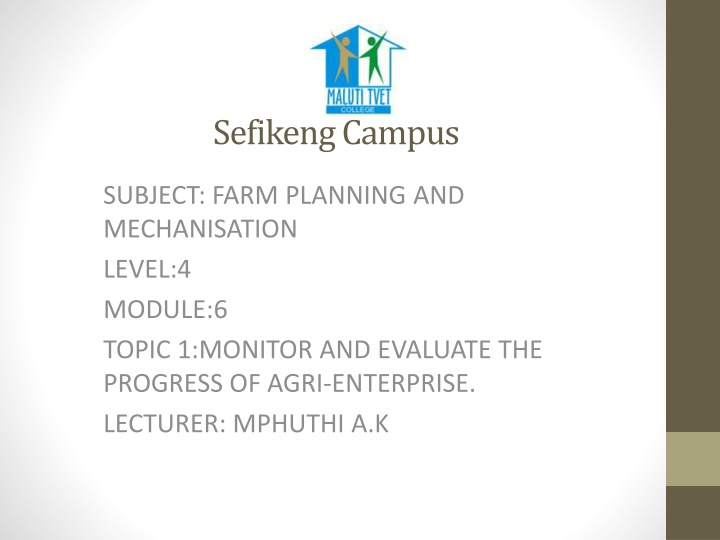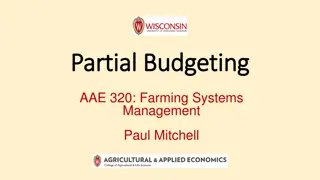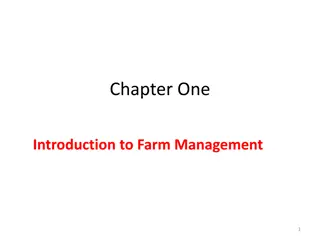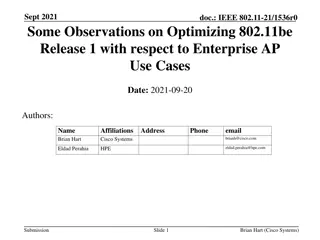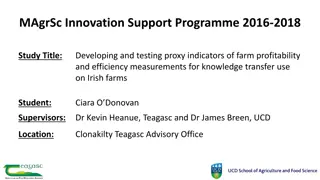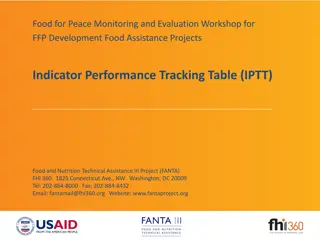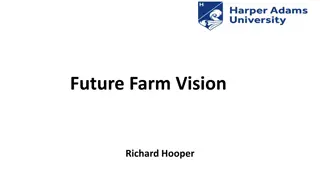Farm Enterprise Progress Monitoring and Evaluation
Understanding the progress of an agri-enterprise involves monitoring production efficiency, returns, and cash income. By assessing factors like yield per hectare and net income, farmers can optimize their operations for increased productivity and profitability. This process requires a comprehensive evaluation of production progress and financial outcomes within a farming system. Through effective monitoring and evaluation, farmers can improve their managerial style and achieve sustainable growth in their agri-enterprise.
Download Presentation

Please find below an Image/Link to download the presentation.
The content on the website is provided AS IS for your information and personal use only. It may not be sold, licensed, or shared on other websites without obtaining consent from the author.If you encounter any issues during the download, it is possible that the publisher has removed the file from their server.
You are allowed to download the files provided on this website for personal or commercial use, subject to the condition that they are used lawfully. All files are the property of their respective owners.
The content on the website is provided AS IS for your information and personal use only. It may not be sold, licensed, or shared on other websites without obtaining consent from the author.
E N D
Presentation Transcript
Sefikeng Campus SUBJECT: FARM PLANNING AND MECHANISATION LEVEL:4 MODULE:6 TOPIC 1:MONITOR AND EVALUATE THE PROGRESS OF AGRI-ENTERPRISE. LECTURER: MPHUTHI A.K
Subject Outcome Monitor and evaluate progress. Learning Outcome Plan how to monitor progress during the year. plan
Introduction A farmer should never regard a farming enterprise as a venture with ceiling or limit there is no ceiling within South African free-market system. There are so many ways in which production efficiency can be improved. Increased livestock production through upgrading of stock. In crop production, different cultivars allow for an increase in crop yield without enlarging the land under production. An improved managerial style can do wonders within an enterprise.
1. Monitoring production progress. Production progress depends on the efficiency of farm system. The efficiency of farming systems can only be estimated when three basic aspects of farm management have been weighed up. They are, production, return and cash income. - The farmer is interested in the overall production of the farm that is, all the products he or she obtains from it - Secondly, the farmer is interested in the return from production factors. This is the production from every unit, e.g. land and cattle. - Thirdly, the farmer is interested in the cash income earned by his or her work on the farm. This is the money available after the sale of farm produce.
Monitoring production progress continues We can express farm income by adding up all the produce for one year, e.g. so many tons of maize were produced and so many head of cattle have been sold. Farmers calculating their produce in this way know exactly the income of the farm per year. This is done by multiplying the sale price (of maize per ton and cattle per head) by the quantities produced. Example: Say a farmer planted 100ha of maize, so in order to get Total yield we say ( yield/ha x total ha= Total yield so that Total yield x sale price of maize/ price per ton of maize= Total income.
2. Assessing return from production factors. 2.1 Return from the land This is the production from a hectare of land during a production season. It is expressed as so many tons (of produce) per hectare. 2.2 Return from money This is the amount of money earned as a results of spending a certain sum. Example: The maize farmer spends R3000 per hectare in producing maize at 4 ton per hectare. The maize is sold at R1500 per ton, giving a net income of R6000 per hectare (R1500 x 4). The return on the money is R6000 R3000 = R3000 (i.e. for every R1 that is spend, R2 is earned)
Assessing return from production factors continues 2.3 Return from livestock This is the annual production per animal. Example: A cow gives birth to a calf which is sold as a weaner for R3000. The return from the cow ( if she is not milked) is therefore R3000 per year. 2.4 Return from labour This is the production obtained from day s work. Example: By working 30 days in a field during a production season, five workers are responsible for a crop of 100 tons of maize. Labour return = 100 / (30 x 5) = 0.6 ton
3. Assessing returns from cultivated fields. Measuring the returns from cultivated fields like maize and wheat fields allows the farmer to make two sets of comparisons. The farmer can compare the cultivated fields like maize and wheat fields allows the farmer to make two sets of comparisons. E.g. fields situated in different parts of the farm, fields where different cultural methods were put into practice, fields with seeds of different varieties etc. The farmer can compare the yield from the same field season after season. The comparison will reveal improvements or deterioration resulting from the methods used.
Assessing returns from cultivated fields continues .. An average yield per hectare for each field is obtained. Table 6.1: average yield per hectare for each field. Field Size of field Production per field Return from field A 10 ha 35 tons 3.5 tons B 20 ha 40 tons 2 tons Field A has a higher return than field B.
4. Income and expenditure of a farm unit. When analyzing cash income on a farm, the situation must be examined carefully from all angles before deciding if farm management is efficient. It can happen that one farmer sells a lot of produce and gets poorer, while another sells a small amount and gets richer. Estimating increased wealth or profitability means calculating the difference between the money earned by the sale of produce ( i.e. the receipts) and the money spend to buy production factors ( i.e. expenditure). The difference between the two is called balance. The balance is obtained by subtracting expenditure (cost of production) from total value of farm production.
Summary The efficiency of farming systems can only be estimated when three basic aspects of farm management have been weighed up and those are: production, return and cash income. Assessing return from production consists of four factors that is, return from the land, return from money, return from livestock and return from labour. Cash income on a farm can only be analyzed when all situation have been examined carefully from all angles. The difference between (receipts) and (expenditure) is balance.
Assessment Activity There are ways in which production efficiency can be improved. Name them? (4) There are three basic aspects of farm management that production progress depends on in terms of efficiency of farming systems. Mention them? (3) Define expenditure? (2) What is the difference between return from labour and return from land? (4) Give a definition of an efficient farmer. (2) Total marks: 15
